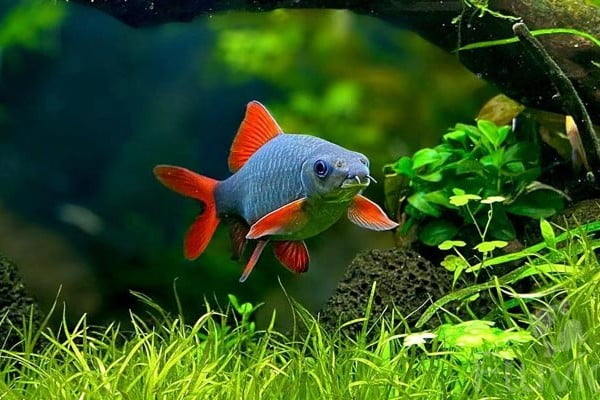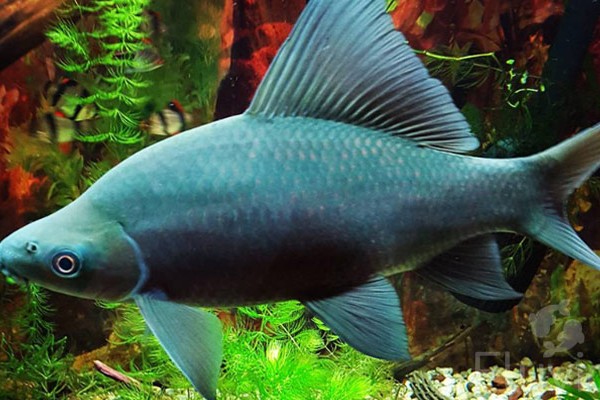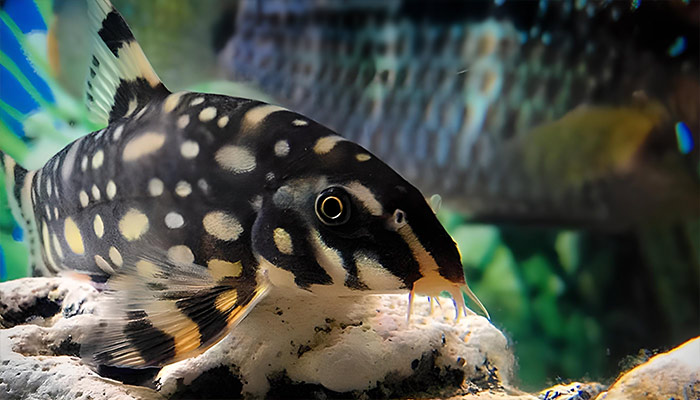2024 Freshwater Aquarium Snail Guide – Set up a new tank, but don’t know which snails to add? Whether you need an algae cleaning crew? Need some extra snail bottom feeders to clean up extra food? This guide is for you!
Whether you’re dealing with a mystery snail invasion (Assassin Snails will help!), need help clearing the algae and food waste or just want to add some cute shelled variety to your aquarium.
This aquarium snail types guide is for you!
Make sure to check out which: Fish love to eat pest snails: Full Guide
From cleaners to entertainers to assassins, we’ve got 28 awesome snails lined up for you that are sure to enhance your aquarium. But tread carefully; while many are beneficial, there are a few shelled nightmares lurking in the waters.
This Aquarium Snail Types Guide is here to help you navigate the fascinating world of aquarium snails – the good, the bad and everything in-between.
Ready to dive in? Let’s get started.
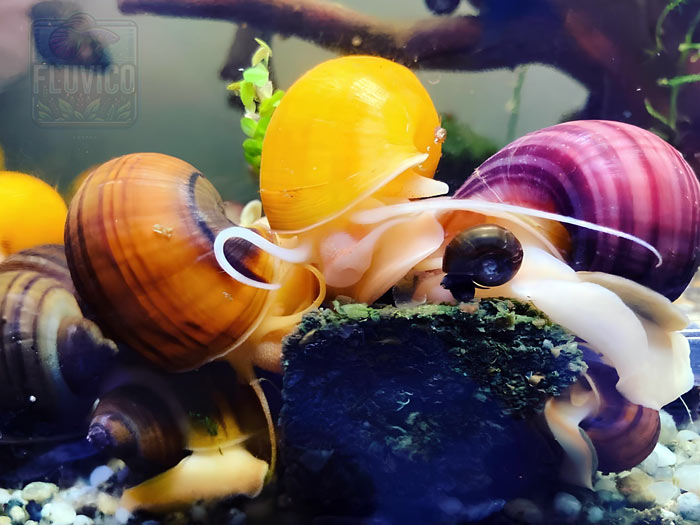
Apple Snail (Pomacea diffusa)
Apple snails are a popular choice for freshwater aquariums due to their vibrant colours and active nature. Although they’ll often hitch-hike into your aquarium when they are small.
Mystery Snails, also known as Apple Snails, are one of the most popular snail species for aquariums due to their algae-eating habits and clean-up crew mentality making them excellent for beginners.
There are 4 common types of aquarium suitable Apple Snails under the ‘Ampullariidae’ family of freshwater snails.
The differences between these snails can often be hard to distinguish, so we recommend just picking the snail based on how cute they look. Their behaviour and eating habits are similar between all the species below except the carnivorous Assassin Snails.
- Pomacea diffusa (Small Spike Top Apple Snail)
- Pomacea maculata (Giant Apple Snail)
- Pomacea bridgesii (Large Spike Top Apple Snail)
- Pomacea canaliculate (Channelled Applesnail)
- Mystery Snails Pomacea – Hitch-hikers
Interesting Fact: Despite its seemingly sluggish nature, the Apple Snail can climb up to 6 feet in a night in search of food!
Interesting Fact 2: Did you know? Apple Snails possess a lung and a gill, allowing them to survive in both aquatic and terrestrial environments.
Interesting Fact about the Channeled Applesnail (Pomacea canaliculata): Despite being aquatic, these snails lay their eggs in a bright pink mass above the water line, where they can be safe from aquatic predators.
- Size: Up to 1-3 inches
- Colour Variations: Yellow, brown, blue, Purple, Striped, Ivory
- Lifespan: 1-3 years
- Lifecycle: Egg, Juvenile, Adult
- Origins: Worldwide (Species Dependant)
- Behaviour: Active, curious
- Social Level: Peaceful
- Activity Level: High
- Diet: Algae, detritus, plant matter
- Reproduction: Sexual, lays eggs above the water line
- Overpopulation Potential: Low-medium (without overfeeding)
- Compatibility with Plants: Can eat soft-leaved plants like Java Fern.
- Algae Eaters: Yes
- Escape Potential: Moderate, lids advised
- Care Level: Easy
- Availability: Common
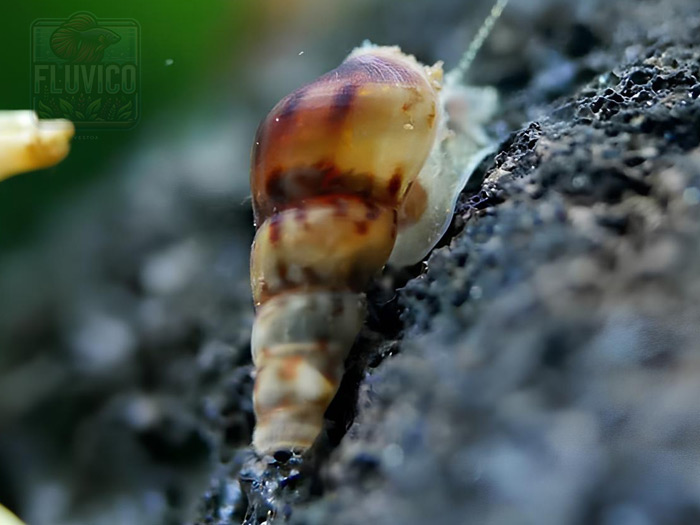
Malaysian Trumpet Snails (Melanoides tuberculatus)
Also known as Red-rimmed Melania, they are night owls of the aquarium world and are appreciated for their substrate-cleaning abilities.
A popular choice among aquarium enthusiasts due to their burrowing habits, which can help to aerate the substrate and promote the health of live plants. Their nocturnal habits offer an intriguing dimension to your tank’s activity during the evening hours.
Interesting Fact: These snails are unique night owls of the snail world. They prefer to bury themselves in the substrate during the day, emerging only at night.
- Size: Up to 1 inch
- Colour Variations: Brown, with possible faint red rim
- Lifespan: 1-2 years
- Lifecycle: Livebearers
- Origins: Africa, Asia
- Behaviour: Burrow in substrate during the day
- Social Level: Peaceful
- Activity Level: High at night
- Diet: Dead plant matter, detritus
- Reproduction: Asexual, gives birth to live young
- Overpopulation Potential: High
- Compatibility with Plants: Safe
- Algae Eaters: Yes
- Escape Potential: Low
- Care Level: Easy
- Availability: Common/Hitch-hikers
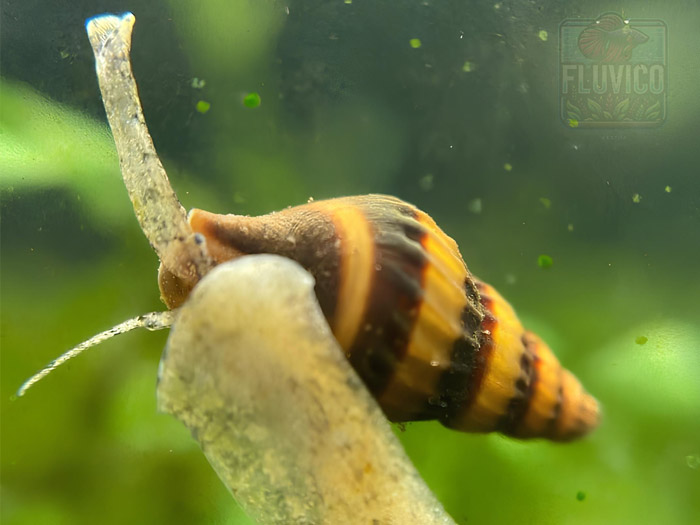
Assassin Snail (Anentome Helena)
The Assassin Snail is the go-to for many hobbyists dealing with unwelcome snail populations. They’re intriguing in their own right with their striking bright yellow shell pattern.
While the thought of an Assassin Snail might sound scary, in our years of experience these little snails live peacefully among fish & shrimp, only cleaning up when necessary.
In a large tank, these snails can stop the overpopulation of mystery snails, trumpets and bladder without complete extermination.
Hiding under the substrate these snails employ a surprise tactic to catch other snails. A social snail, you’ll often find them in groups.
- Size: Up to 1 inch
- Colour Variations: Brown, yellow, black banded
- Lifespan: Up to 2 years
- Lifecycle: Egg, Juvenile, Adult
- Origins: Southeast Asia
- Behaviour: Predatory on other snails
- Social Level: Peaceful with non-snails
- Activity Level: Moderate
- Diet: Carnivorous, prefer other snails
- Reproduction: Sexual, lays individual eggs
- Overpopulation Potential: Low
- Compatibility with Plants: Safe
- Algae Eaters: No
- Escape Potential: Low
- Care Level: low/Intermediate
- Availability: Common
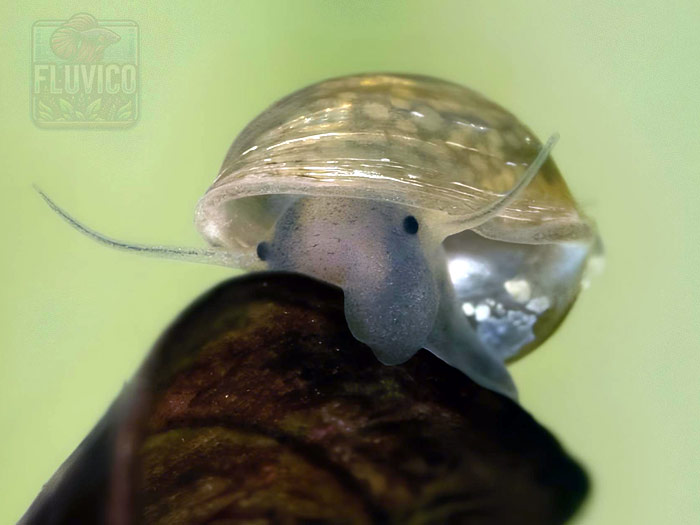
Bladder Snail (Physella Acuta) – Pest Alert!
Bladder Snails, also known as Tadpole Snails & Acute Bladder Snails, are great at clearing up uneaten food and algae, making them beneficial to keeping the tank clean.
The downside? These little snails are prolific breeders, laying multiple clutches of eggs daily. With an abundance of leftover fish food or algae, you can have an overpopulation problem in just a few weeks.
They often choose to lay their eggs on the glass side of your aquarium which, for some, isn’t the most aesthetic look. Add 2-3 assassin snails to keep these little hitch-hiker snails in check.
Interesting Fact: Bladder Snails can lay over 100 eggs per week!
- Size: Up to 0.6 inches
- Colour Variations: Pale, translucent, brown spots.
- Lifespan: Up to 1 year
- Lifecycle: Livebearers
- Origins: Worldwide
- Behaviour: Active cleaners
- Social Level: Peaceful
- Activity Level: High
- Diet: Algae, detritus, leftover food
- Reproduction: Hermaphrodites, Eggs (10-40 clutch)
- Overpopulation Potential: Very High
- Compatibility with Plants: Safe
- Algae Eaters: Yes
- Escape Potential: Low
- Care Level: Easy
- Availability: Common/Hitch-hikers
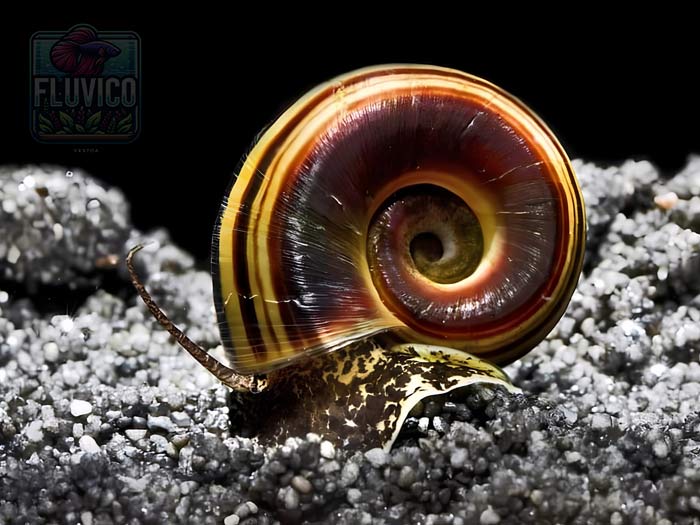
Columbian Giant Ramshorn Snail (Marisa Cornuarietis)
The Giant Ramshorn Snail is an impressive species due to its size and striking shell pattern. While they can be a bit too efficient with plant consumption, they are great for controlling algae.
Interesting Fact about Marisa cornuarietis (Giant ramshorn snail): They’re one of the few snail species that eat plants voraciously and can quickly decimate an aquarium’s plant life if unchecked.
- Size: Up to 2 inches
- Colour Variations: Yellow, brown with dark stripes
- Lifespan: Up to 1-2 years
- Lifecycle: Egg, Juvenile, Adult
- Origins: North and Central America
- Behaviour: Active
- Social Level: Peaceful
- Activity Level: High
- Diet: Algae, plant matter
- Reproduction: Sexual, lays eggs in a gelatinous mass
- Overpopulation Potential: Medium
- Compatibility with Plants: Not safe, eats most aquatic plants
- Algae Eaters: Yes
- Escape Potential: Low
- Care Level: Intermediate
- Availability: Common
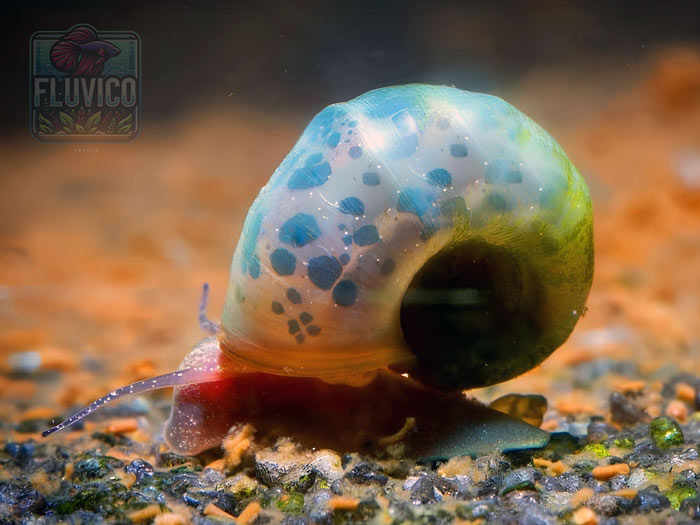
Great Ramshorn (Planorbarius Corneus)
This attractive and large snail species is named for the ram’s horn shape of its shell. They are often used as both decorative additions and practical cleaners.
Interesting Fact: There is a large ramshorn snail whose shell resembles a coiled rope, which gives it the name translating to ‘horn shell’.
- Size: Up to 1.5 inches
- Colour Variations: Brown, red, blue
- Lifespan: Up to 1-2 years
- Lifecycle: Egg, Juvenile, Adult
- Origins: Europe
- Behaviour: Peaceful, nocturnal
- Social Level: Peaceful
- Activity Level: Moderate
- Diet: Algae, detritus, plant matter
- Reproduction: Hermaphroditic, lays eggs in a gelatinous mass
- Overpopulation Potential: Medium
- Compatibility with Plants: Safe
- Algae Eaters: Yes
- Escape Potential: Low
- Care Level: Easy
- Availability: Fairly common
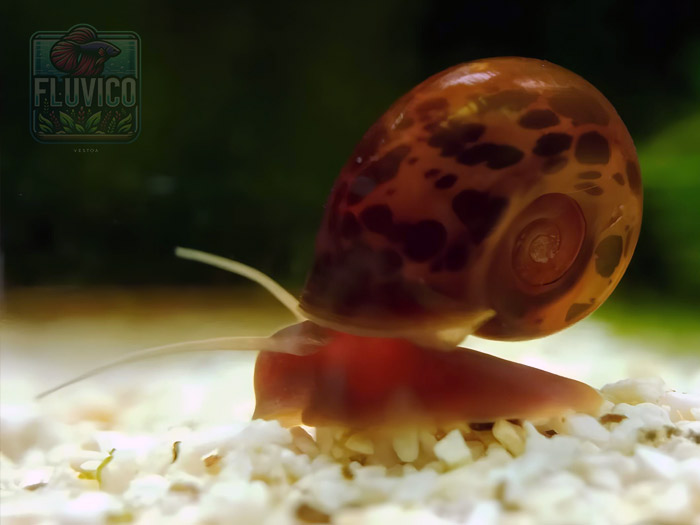
Dwarf Seminole Ramshorn Snail (Planorbella Duryi)
This is a smaller species of the Ramshorn Snail. Its petite size and attractive shell make it a favourite for smaller aquariums. Dwarf Ramshorn Snails are diligent cleaners, always on the hunt for uneaten food and algae.
Interesting Fact about Planorbella duryi: These snails are adaptable to a variety of environments and can even live in slightly salty water.
- Size: Up to 0.5 inches
- Colour Variations: Brown, red, blue
- Lifespan: Up to 1 year
- Lifecycle: Hermaphroditic, lays eggs in gelatinous mass
- Origins: North America
- Behaviour: Active
- Social Level: Peaceful
- Activity Level: High
- Diet: Algae, detritus, leftover food
- Reproduction: Hermaphroditic, lays eggs in clusters
- Overpopulation Potential: Medium
- Compatibility with Plants: Safe
- Algae Eaters: Yes
- Escape Potential: Low
- Care Level: Easy
- Availability: Common
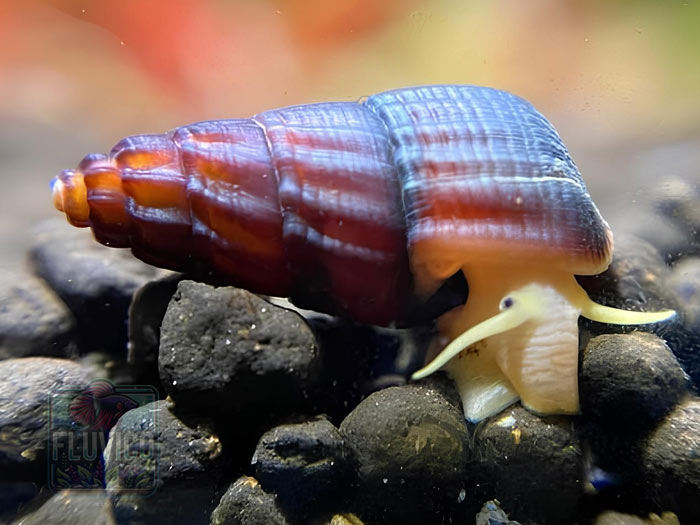
Rabbit Snail (Tylomelania)
Rabbit Snails, native to Indonesia, have unique elongated shells that resemble a rabbit’s ear, hence their name. They’re peaceful and ideal for community tanks.
Interesting Fact: Named for their rabbit-like faces and long, drooping antennae, certain snails are among the slowest even in the snail kingdom, moving just a few inches per day.
- Size: Up to 4 inches
- Colour Variations: Yellow, Blue, Brown & Black
- Lifespan: Up to 3 years
- Lifecycle: Livebearers
- Origins: Indonesia
- Behaviour: Peaceful, slow-moving
- Social Level: Peaceful
- Activity Level: Low
- Diet: Algae, detritus, plant matter
- Reproduction: Sexual, gives birth to live young
- Overpopulation Potential: Low
- Compatibility with Plants: Safe
- Algae Eaters: Yes
- Escape Potential: Low
- Care Level: Intermediate
- Availability: Uncommon
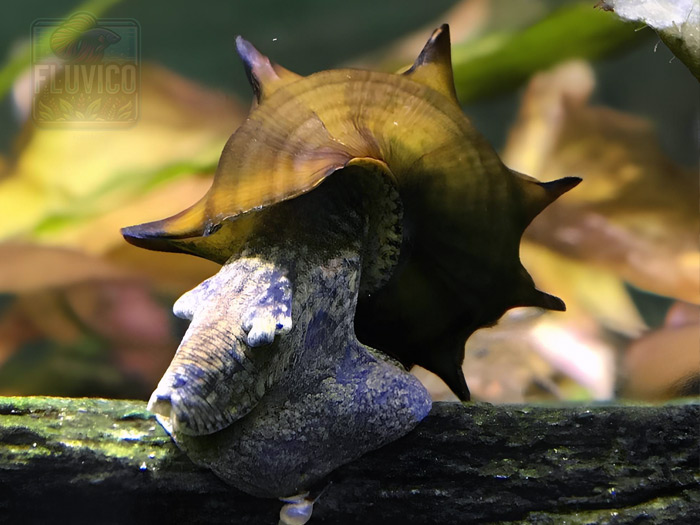
Pagoda Snail (Brotia Pagodula)
The Pagoda Snail, known for its towering, pagoda-like shell, is a freshwater species from Southeast Asia. They make a unique and low-maintenance addition to community tanks, where they happily scour the tank for detritus and algae.
Interesting Fact about Brotia pagodula: These freshwater snails are known to be climbers, and they can often be seen attached to the glass walls of an aquarium, providing a view of their interesting underbellies.
- Size: Up to 2 inches
- Colour Variations: Brown, red
- Lifespan: Up to 3 years
- Lifecycle: Egg, Juvenile, Adult
- Origins: Southeast Asia
- Behaviour: Peaceful, slow-moving
- Social Level: Peaceful
- Activity Level: Moderate
- Diet: Algae, detritus
- Reproduction: Sexual, lays eggs on hard surfaces
- Overpopulation Potential: Low
- Compatibility with Plants: Safe
- Algae Eaters: Yes
- Escape Potential: Low
- Care Level: Intermediate
- Availability: Uncommon
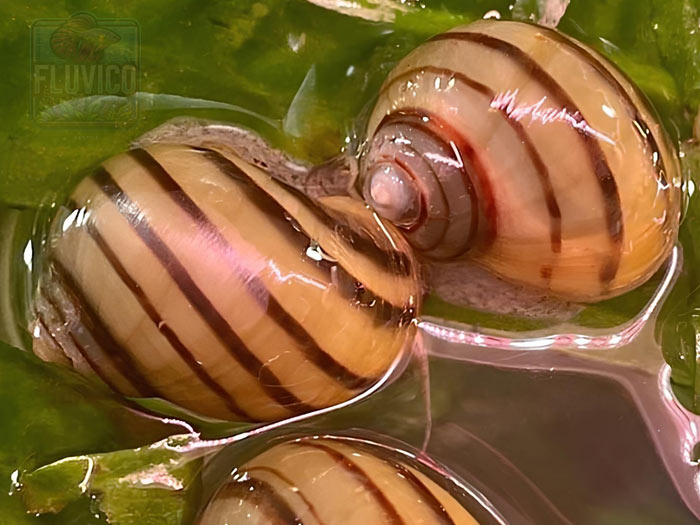
Zebra Apple Snail (Pixi Snail) (Asolene Spixi)
The Asolene Spixi, also known as the Zebra Apple Snail, is an attractively patterned species that can add a touch of vibrancy to your tank. They’re known for their algae-eating habits and for being low-maintenance pets.
Interesting Fact about Asolene: Asolene snails, while they can self-fertilize, prefer cross-fertilization. This is because the latter method promotes genetic diversity and the health of offspring.
- Size: Up to 2 inches
- Colour Variations: Yellow and black stripes
- Lifespan: Up to 3 years
- Lifecycle: Egg, Juvenile, Adult
- Origins: South America
- Behaviour: Peaceful
- Social Level: Peaceful
- Activity Level: Moderate
- Diet: Algae, detritus
- Reproduction: Sexual, lays eggs on hard surfaces
- Overpopulation Potential: Low
- Compatibility with Plants: Safe
- Algae Eaters: Yes
- Escape Potential: Low
- Care Level: Easy
- Availability: Uncommon

Zebra Nerite Snails (Neritina natalensis)
Known for their attractive black and gold striping, Zebra Nerite Snails make for an eye-catching addition to any aquarium. They’re also avid algae-eaters, making them great for maintaining cleanliness in your tank.
Interesting Fact about Zebra Nerite Snails (Neritina natalensis): Zebra Nerite Snails possess stunning stripes, unique to each individual, much like a zebra’s, hence the name!
- Size: Up to 1 inch
- Colour Variations: Black and yellow/gold stripes
- Lifespan: Up to 2 years
- Lifecycle: Egg, Juvenile, Adult
- Origins: East Africa
- Behaviour: Peaceful, slow-moving
- Social Level: Peaceful
- Activity Level: High
- Diet: Algae, detritus
- Reproduction: Sexual, lays eggs but needs brackish water for larvae to survive
- Overpopulation Potential: Zero (Saltwater needed)
- Compatibility with Plants: Safe
- Algae Eaters: Yes
- Escape Potential: Low
- Care Level: Easy
- Availability: Common
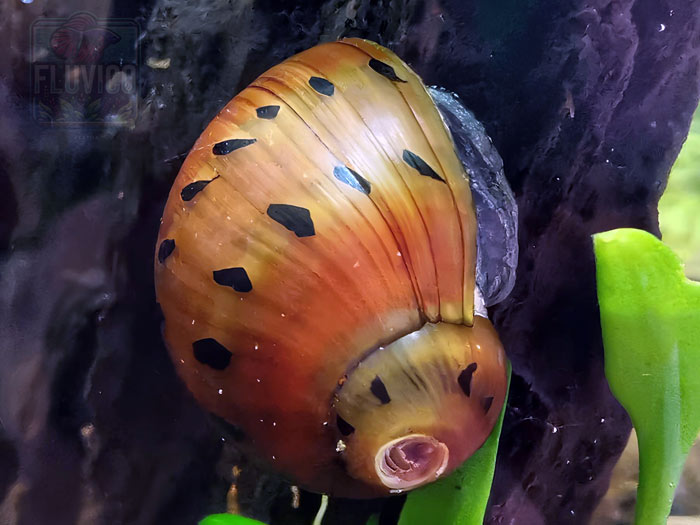
Tiger Nerite Snails (Vittina semiconica)
The Tiger Nerite Snail is a smaller species with a shell pattern resembling tiger stripes. It is renowned for its algae-eating habits, making it an ideal choice for keeping your aquarium’s glass and decorations clean.
Interesting Fact about Tiger Nerite Snails (Vittina semiconica): Despite their fierce name, Tiger Nerite Snails are peaceful algae eaters, adding both beauty and cleanliness to your aquarium.
- Size: Up to 1 inch
- Colour Variations: Brown, orange and black stripes
- Lifespan: Up to 2 years
- Lifecycle: Egg, Juvenile, Adult
- Origins: Southeast Asia
- Behaviour: Peaceful
- Social Level: Peaceful
- Activity Level: High
- Diet: Algae, detritus
- Reproduction: Sexual, lays eggs but needs brackish water for larvae to survive
- Overpopulation Potential: Zero (Saltwater needed)
- Compatibility with Plants: Safe
- Algae Eaters: Yes
- Escape Potential: Low
- Care Level: Easy
- Availability: Common
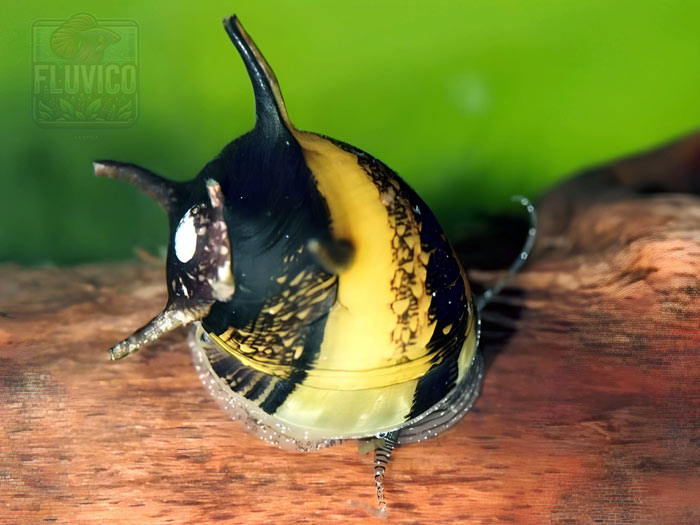
Horned Nerite Snails (Clithon corona/diadema)
With their unique, horned shells, Horned Nerite Snails are an interesting addition to any aquarium. They are peaceful and are excellent algae eaters.
Interesting Fact about Horned Nerite Snails (Clithon corona/diadema): The Horned Nerite Snails boast small ‘horns’ on their shells, making them one of the most uniquely adorned snails you can add to your aquarium.
- Size: Up to 1 inch
- Colour Variations: Yellow, brown, orange & black with small horn-like projections
- Lifespan: Up to 2 years
- Lifecycle: Egg, Juvenile, Adult
- Origins: Southeast Asia
- Behaviour: Peaceful
- Social Level: Peaceful
- Activity Level: High
- Diet: Algae, detritus
- Reproduction: Sexual, lays eggs but needs brackish water for larvae to survive
- Overpopulation Potential: Zero (Saltwater needed)
- Compatibility with Plants: Safe
- Algae Eaters: Yes
- Escape Potential: Low
- Care Level: Easy
- Availability: Uncommon
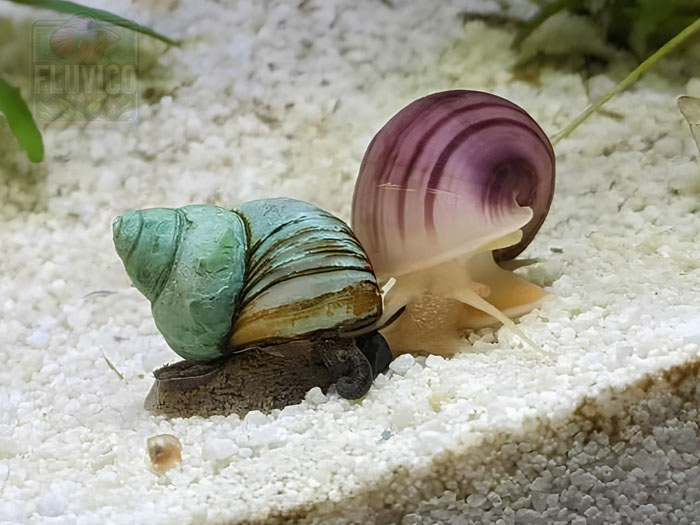
Japanese Trapdoor Snails (Cipangopaludina japonica)
The Japanese Trapdoor Snail is a large, hardy species known for its ability to withstand a range of conditions. They’re not only beneficial as algae-eaters but also contribute to the decomposition of organic matter.
- Size: Up to 2 inches
- Colour Variations: Green, brown, black
- Lifespan: Up to 5 years
- Lifecycle: Livebearers
- Origins: East Asia
- Behaviour: Peaceful
- Social Level: Peaceful
- Activity Level: Moderate
- Diet: Algae, detritus, plant matter
- Reproduction: Sexual, gives birth to live young
- Overpopulation Potential: Low
- Compatibility with Plants: Safe
- Algae Eaters: Yes
- Escape Potential: Low
- Care Level: Easy
- Availability: Common
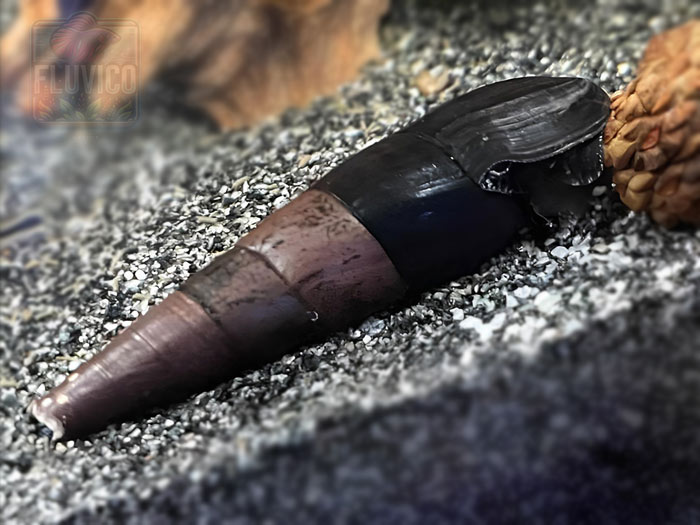
Lava Snail or Devil Snails (Faunus ater)
The Black Devil Snail is a larger species with a striking, glossy black shell. They are perfect for experienced aquarium owners looking for a unique addition to their freshwater tank.
- Size: Up to 4 inches
- Colour Variations: Black or Dark Brown (Cappuccino Variant)
- Lifespan: Up to 5 years
- Lifecycle: Egg, Juvenile, Adult
- Origins: Southeast Asia
- Behaviour: Peaceful
- Social Level: Peaceful
- Activity Level: Low
- Diet: Detritus, plant matter
- Reproduction: Sexual, lays eggs on hard surfaces
- Overpopulation Potential: Low
- Compatibility with Plants: Can potentially eat soft plants
- Algae Eaters: No
- Escape Potential: Low
- Care Level: Intermediate
- Availability: Uncommon

Ivory Snail (Babylonia spirata)
Ivory Snails, known for their beautifully shaped shells and attractive ivory colour, are not your typical aquarium snails. They are marine snails, which means they inhabit saltwater tanks. Despite this distinction, they’re relatively easy to care for and make an excellent choice for aquarists looking to add variety to their marine tanks.
- Size: Up to 2 inches
- Colour Variations: Ivory
- Lifespan: Up to 5 years
- Lifecycle: Egg, Larvae, Juvenile, Adult
- Origins: Western Pacific Ocean
- Behaviour: Peaceful
- Social Level: Peaceful
- Activity Level: Low
- Diet: Detritus, meaty foods
- Reproduction: Sexual, releases larvae into the water
- Compatibility with Plants: Safe, if marine plants are used
- Algae Eaters: No
- Escape Potential: Low
- Care Level: Intermediate, due to the need for a saltwater environment
- Availability: Uncommon
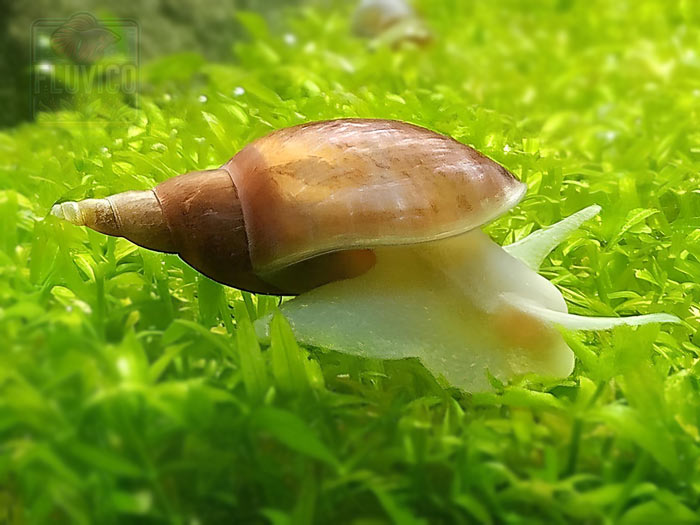
Great Pond Snail (Lymnaea Stagnalis )
The Great Pond Snail is one of the largest freshwater snails and makes a unique addition to an aquarium. Their translucent bodies provide a fascinating look into their internal workings, making them great educational subjects too.
Interesting Fact about Lymnaea stagnalis (Great Pond Snail): They can reach impressive sizes and have been known to eat small fish when food is scarce!
- Size: Up to 2-3 inches
- Colour Variations: Translucent, pale to dark brown
- Lifespan: Up to 1 year
- Lifecycle: Egg, Juvenile, Adult
- Origins: Europe, Asia
- Behaviour: Peaceful
- Social Level: Peaceful
- Activity Level: Moderate
- Diet: Algae, detritus, plants
- Reproduction: Sexual, lays eggs on solid surfaces
- Overpopulation Potential: Medium
- Compatibility with Plants: Mostly safe, but can eat live plants
- Algae Eaters: Yes
- Escape Potential: Low
- Care Level: Easy
- Availability: Common
